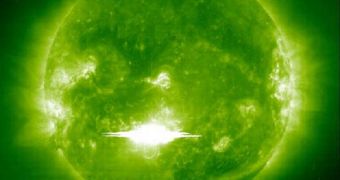Over the past couple of years, many individuals with precarious understandings of science have said that a massive solar flare will swell up from the Sun in 2012, killing everyone on Earth and destroying the planet. That is, simply put, absolutely impossible, NASA researchers explain.
What is very important to know about this category of doomsayers is that they use solid scientific facts up to a point, beyond which they simply speculate. Due to the fact that half of their reasoning, very few other people bother to think whether the other fact is correct as well.
As such, many have accepted that the current solar cycle is getting ready to reach its peak, maximum activity in 2013-2014, but also that this will coincide with our planet's destruction. In reality, the solar cycle will peak and then wane, while Earth will continue to occupy the same orbit it always had.
No amount of electromagnetic energy and highly-energetic particles and radiations released from the Sun is sufficient to destroy a planet, not even Mercury or Venus. Short of swelling as a red giant or blowing up as a supernova, there is nothing our parent star can do to destroy its planets.
The Sun will indeed turn into a red giant, and expand beyond the orbit of Earth, destroying the first three rocky planets, and maybe even Mars. However, all of us will be comfortably dead at that time, about 5 billion years from now. Also, a Sun-sized star is too small to go supernova.
In addition, NASA says, there is no reason to believe that the current solar cycle will be any different from all others on record. One of the reasons why experts are so confident is that there are now more spacecraft observing the star around the clock than ever before.
“This same solar cycle has occurred over millennia. Anyone over the age of 11 has already lived through such a solar maximum with no harm. In addition, the next solar maximum is predicted to occur in late 2013 or early 2014, not 2012,” a press release from the American space agency reads.
“Most importantly, however, there simply isn't enough energy in the Sun to send a killer fireball 93 million miles to destroy Earth,” the NASA statement explains. At the same time, this does not imply that activity from the Sun cannot adversely affect our planet.
Massive solar flares can pierce through the magnetosphere, potentially frying power grids and satellites, affecting communications, and endangering the lives of astronauts on the International Space Station (ISS). However, this is a far cry from destroying the entire planet.
“We can't ignore space weather, but we can take appropriate measures to protect ourselves. And, even at their worst, the sun's flares are not physically capable of destroying Earth,” NASA concludes.

 14 DAY TRIAL //
14 DAY TRIAL //